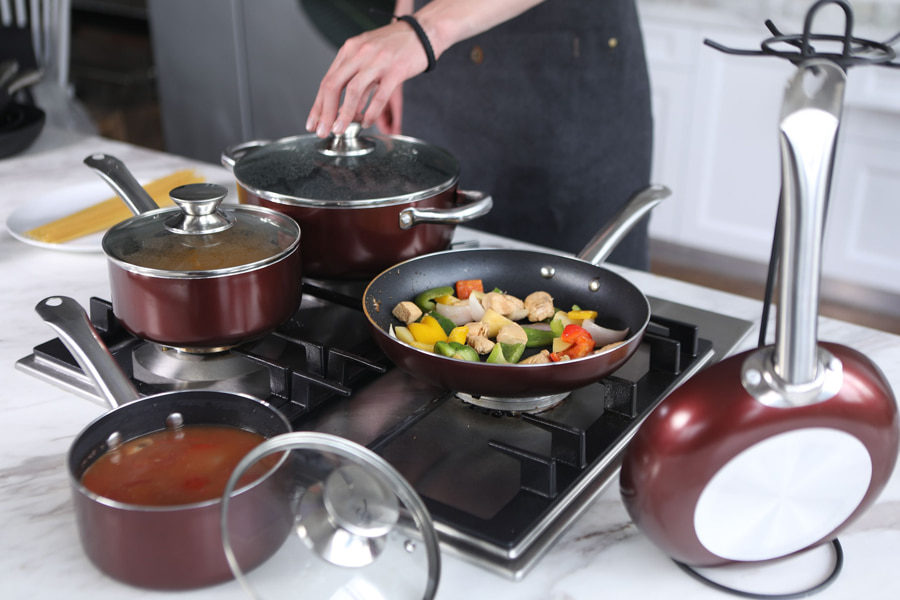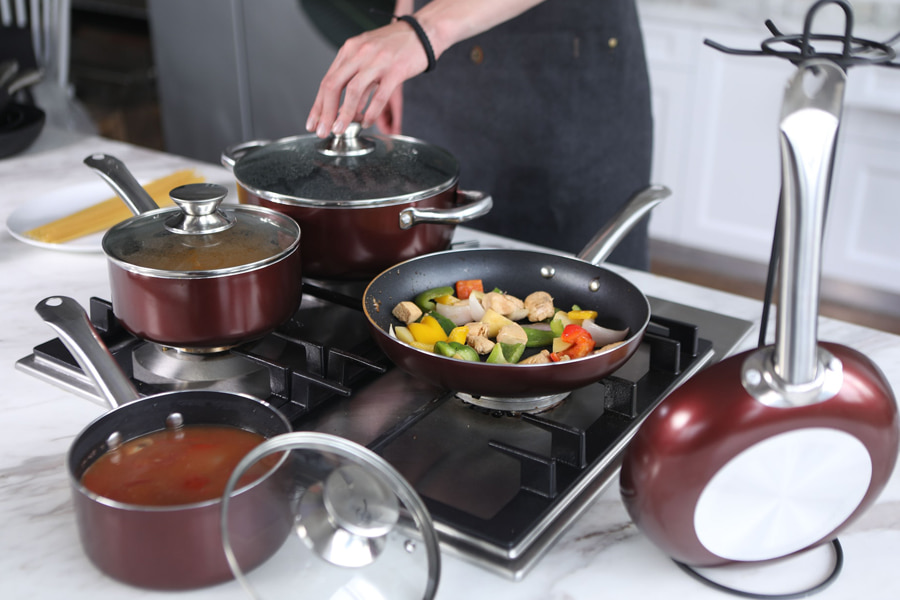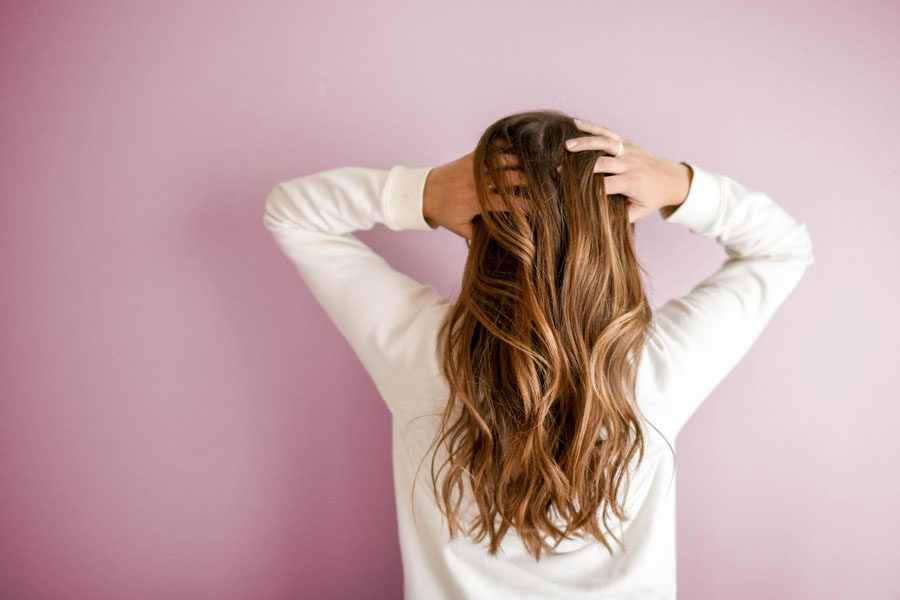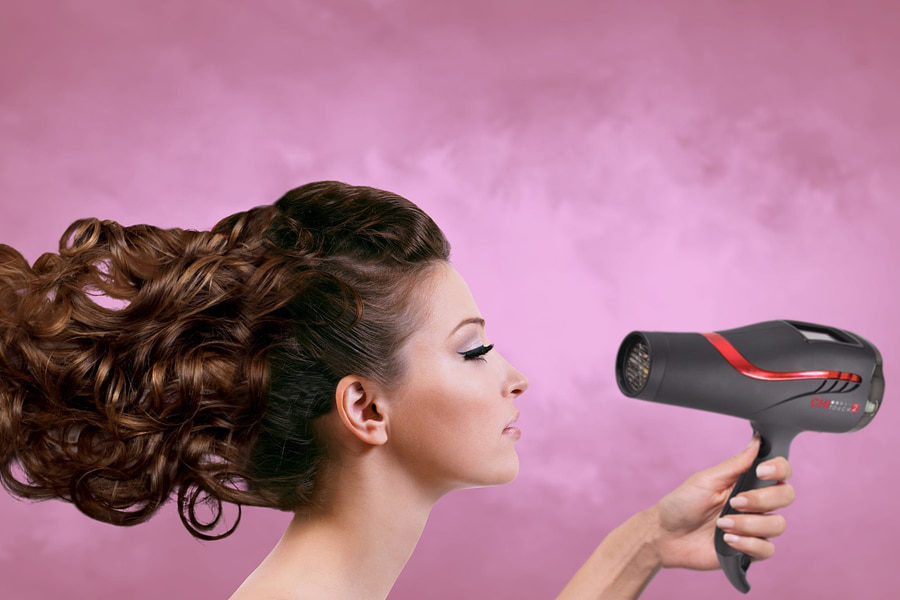
Sometimes, it can be difficult to know which cookware you really need in your kitchen. Whether you’re building your first kitchen’s cookware set or simply removing outdated and old equipment, you should avoid the items that just take up space in your pantry. However, you must be ready with the essential and needed pots and pans arsenal for weeknight dinners, laid-back brunches, and a variety of other culinary adventures. But keep in mind that having a large collection of pots and pans isn’t essential. Having a mix of the right ones, on the other hand, is. Among them, every cook’s kitchen should have at least one nonstick pan. No one enjoys their favorite dish sticking to the pan’s bottom. Imagine having the nonstick version of all of the essential pots and pans? Life will be easier, right? So, let’s learn about the Best Nonstick Cookware Set on the market!
T-fal Ultimate Hard Anodized Aluminum Nonstick Cookware Set, 17 piece | Best Nonstick Cookware Set
For more than 60 years, T-fal has strived to make the lives of busy home cooks easier by providing innovative, high-performing, and user-friendly cookware. As the industry leader in non-stick cookware, T-fal tries their best to develop innovative product solutions that eliminate the hassle and stress in the kitchen. The T-fal Ultimate Hard Anodized Nonstick 17 Piece Cookware Set we’re going to talk about today has a wide range of pots and pans that you’ll find perfect to use for a variety of purposes.
Pieces Included in the Best Nonstick Cookware Set
Firstly, let’s see what comes with this set.
- 1 egg wonder fry pan
- 10.25″ fry pan
- 10.25″ square griddle
- 11.5″ fry pan with lid
- 1qt. saucepan with lid
- 2qt. saucepan with lid
- 3.5qt. deep sauté
- 3qt. Saucepan with lid
- 3qt. steamer insert with 2 side handles
- 5qt. dutch oven with lid
- 8″ Frypan
Now it’s time to take a look at what each pot and pan is used for in our kitchens, as well as what you can cook with them.
1. Dutch Oven
One of the most important kitchen tools a home cook can have is a Dutch oven. For 400 years or so, this huge heavy pot with its tight-fitting lid has been churning out stews, braises, roasts, and even bread. Dutch ovens actually resemble heavy-duty pots. They have thick walls with lids that help trap heat and steam, allowing them to cook food evenly. They also have sturdy handles and durable designs. Stews, sauces, soups, braises, and any other moist-heat cooking method work well in Dutch ovens. You can brown the meat and vegetables on the stove and then leave them to simmer, or you can finish cooking them in the oven. As a result, you’ll appreciate the T-fal Ultimate Hard Anodized Nonstick 17 Piece Cookware Set’s 5 quart range covered Dutch oven.
2. Covered Saucepan
A saucepan has a prominent position among the realm of cookware as one of the most important pots and pans. It’s versatile and generally irreplaceable, despite its name. They’re in every professional kitchen to every home kitchen. Anything that is mostly liquid cooks well in a saucepan. This means it’s great for stewing, soups, simmering, and sauces like pasta sauce. However, they’re not great for making large quantities of soup or stew because they’re usually in the 2-3 quart range (this set comes with three covered saucepans with the sizes of 3, 2 and 1 quart). A saucepan, on the other hand, is ideal for making smaller batches.
3. Steamer Insert
Steaming is a healthy way to cook a variety of foods, including vegetables, fish, and dumplings, without compromising nutrient quality or flavor. To do that, a basket steamer or steamer insert is needed at home. If you have a wok or a shallow pan, you can use a metal steamer insert, like the 3 quart range steam insert that comes with this set. This basic kitchen item is inserted directly into the pot or pan and then cooked on the stove or in the microwave. Simply pour a little water into the pot, place your vegetables or the food you are going steam in the steamer insert, and cover the pot with the lid. As you bring the water to a boil, the steam will condense and cook your food.
4. Sauté Pan
A sauté pan is a good purchase if you do a lot of sautéing and pan frying but also want a pan you can use for braising, deep frying, poaching and other things that require a lot of liquid. This pan, also known as a deep skillet or sauté pan, sits in the middle of a frying pan and a saucepan. They are ideal for braising chicken legs or greens, preparing a curry, or making chutney because the higher sides allow for more liquid to be reduced. However, a sauté pan isn’t ideal for stir frying, which requires high heat and constant movement of small pieces of food up the sides of the pan to maintain temperature control, that’s where the next pan we are going to discuss comes handy – frying pan.
5. Frying Pan
What is the most regularly used cooking vessel in your kitchen? The majority will respond with a frying pay. After all, why not? They’re perfect for everything from frying eggs, fish, grilled cheese to making pancakes, pasta sauce and even cooking burgers. A frying pan, also known as a skillet, is a shallow cooking vessel with curved or sloped sides that allow for rapid evaporation when cooking. It is thick enough to conduct heat evenly when frying foods over moderate to high heat. Pan frying, stir frying, and sautéing can all be done in a frying pan on the stovetop. Skillets are commonly sold without lids because they are intended for tasks that do not require a cover. 10-inch and 12-inch pans are the most popular sizes for all-purpose cooking (and the frying pan comes with this set is 11.5 inches)
6. Griddle Pan
If you have a griddle pan at home, satisfying your craving for a smoky chargrilled steak becomes a breeze. The cooking surface of a griddle is large, with lower walls. Mostly, they come in square or rectangular shape to provide more cooking space than a standard round pan. A griddle pan’s material (usually features cast iron and has a nonstick surface) makes it suitable for use on all types of stovetops, including gas and ceramic. The smooth and flat surface of a griddle is ideal for cooking breakfast foods such as sausages, pancakes, bacon, French toast, and eggs. In addition, grilled cheese sandwiches, quesadillas, and anything else that would normally be cooked in a frying pan can also be made on a griddle. Furthermore, the raised bars also help to remove excess fat from the food.
7. One Egg Wonder
In addition to all of the other essential kitchen pots and pans included in this set, it also includes a one-egg wonder pan. The smaller surface area of this fry pan is ideal for cooking one egg that fit seamlessly on a bagel or bun for a quick breakfast sandwich. The nonstick surface of this fry pan allows for easy turning with a spatula, making it ideal for single servings or perfectly sized portions.
Other Product Details
With its wide variety of pots and pans for frying, browning, sautéing, steaming, slow cooking, and more, T-Fal ultimate hard anodized nonstick cookware offers multi-purpose versatility. This cookware has a tough hard-anodized aluminum construction and includes,
- T fall’s heat mastery system.
- a non-warping, evenly heated base.
- Thermo spot technology.
- Exceptional corrosion and scratch resistance.
Here is a summary of the product specification:
- Primary Material – Hard-Anodized Aluminum
- Handle Material Type – Rubber
- Non Stick Type – Polytetrafluoroethylene (PTFE) Coating
- Enameled – No
- Lid(s) Material – Glass
- Stovetop Safe – Yes
- Oven Safe – Yes
- Maximum Temperature – 400°F
- Cool Touch Handle(s) – Yes
- Product Care – Dishwasher Safe
- Scratch Resistant – Yes
- PFOA Free – Yes
Is Nonstick Cookware Safe?
There has been debate over the years about whether nonstick pans are safe to use. This is because traditional nonstick pans used to be made with Teflon (also known as PTFE). Teflon is a material that, when heated to high temperatures, releases compounds into the air that are linked to cancer.
But, today, many nonstick pans don’t include PTFE. So, nonstick cookware is safe as long as it is used properly and not overheated, according to Robert L. Wolke, Ph.D., a professor emeritus of chemistry at the University of Pittsburgh and the author of What Einstein Told His Cook: Kitchen Science Explained. At 500 degrees Fahrenheit, PTFE begins to decompose, and at 660 degrees Fahrenheit, it begins to decompose considerably. So use your nonstick pans on a medium or low flame.
And there was once concern about consuming Teflon coating if it flaked off the pan, Lisa McManus, executive testing and tasting editor for America’s Test Kitchen, says that manufacturers have improved their ability to cautiously bond the Teflon to the pan so that it does not come off. However, even if someone ate a flake, it would not be hazardous.
Tips for Using Nonstick Cookware
Follow these guidelines for safe everyday use and to prevent damage and wear to your nonstick pans.
- Avoid scratching the nonstick coating with metal utensils. Wooden spoons and silicone utensils without sharp edges should always be safe to use.
- Before using nonstick pans, make sure they’re clean and well-seasoned.
- Don’t ever heat an empty pan because it will heat up much faster and reach 500 Fahrenheit much faster.
- Don’t wash nonstick cookware in the dishwasher because the coating will wear out faster.
- Avoid using nonstick spray. Cooking sprays burn at a lower temperature than nonstick coatings, and as a result, they can damage your pans.
- To cook with nonstick, use medium or low heat, but check the manufacturer’s instructions for the best temperature.
- You won’t need as much oil as you would in a stainless steel pan because the pan will be coated.
Best Nonstick Cookware Set | Conclusion
Just as you need the right equipment (check out the equipment used in rugby, boxing, field hockey, baseball, football) to win a game in addition to the skill, having the right cookware in addition to your culinary skills has a direct impact on winning your cooking game. Your nonstick cookware makes a variety of recipes simple to prepare. You’ll want to have at least a couple on hand in your kitchen because it’s nearly impossible to make eggs without one, they make pan searing fish a lot easier, and they keep pancakes from tearing apart in the pan. So, why not give the best nonstick cookware set on the market a try?



